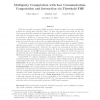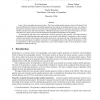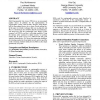130 search results - page 2 / 26 » How to Encrypt with a Malicious Random Number Generator |
IJISEC
2008
13 years 5 months ago
2008
Abstract This paper surveys the literature on certificateless encryption schemes. In particular, we examine the large number of security models that have been proposed to prove the...
IACR
2011
12 years 5 months ago
2011
Fully homomorphic encryption (FHE) provides a simple template for secure computation between two parties (Alice and Bob) where: (I) Alice encrypts her input under her key, (II) Bo...
IJISEC
2010
13 years 3 months ago
2010
The inherent key escrow problem is one of the main reasons for the slow adoption of identity-based cryptography. The existing solution for mitigating the key escrow problem is by a...
SP
2006
IEEE
13 years 11 months ago
2006
IEEE
Linux is the most popular open source project. The Linux random number generator is part of the kernel of all Linux distributions and is based on generating randomness from entrop...
FPGA
2004
ACM
13 years 9 months ago
2004
ACM
Field Programmable Gate Arrays (FPGAs) are an increasingly popular choice of platform for the implementation of cryptographic systems. Until recently, designers using FPGAs had le...



